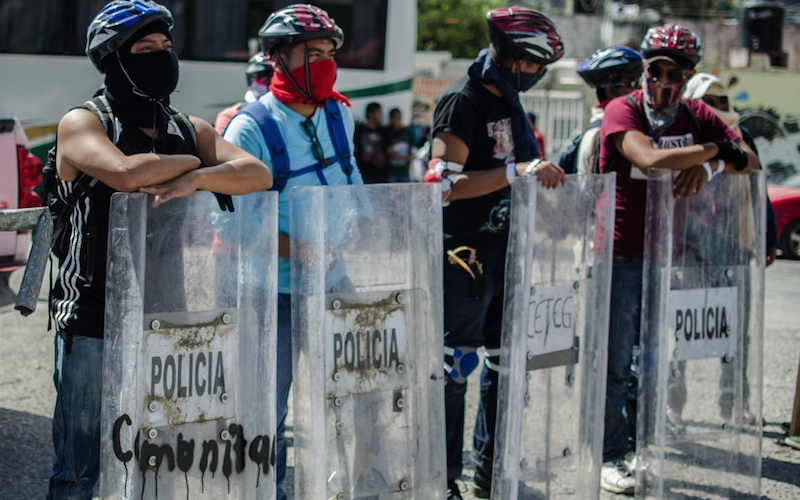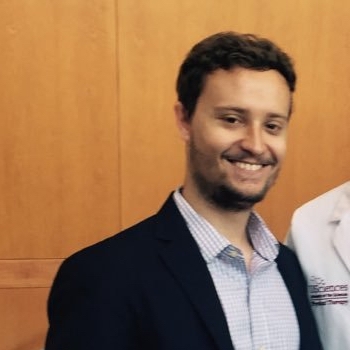
The Coming ‘Mexican Winter’
After a rarely transparent month of investigations, despair enveloped Mexico over the weekend of November 8th when authorities offered grim news about the fate of Iguala’s 43 missing college students. Three suspects confessed to killing the students while in custody, and claimed that command laid with the Guerreros Unidos cartel, according to Mexico’s attorney general Jesus Murillo Karam. The news has since prompted historic demonstrations across the nation. There are marches and protests nearly every day in Mexico. Somewhere between a battle-cry for revenge and a call for government reform, demonstrations have become violent.
The events are leading to an inevitable and dangerous large-scale clash between protestors and Mexican paramilitary police forces — epitomized by the burning of Guerro’s local legislature building, yesterday. While Mexico’s nationwide protests have amassed little mainstream media coverage in the US — maybe for good reason — Department of State officials are keeping a close tab on the situation as a ‘Mexican Spring’ may soon be on the horizon.
For Mexico, the protest’s turning point may have come during a five-hour meeting, on October 28th, between the family members of the missing students and the President in Los Pinos Presidential palace. The blunt talk and disappointment expressed by the families was widely publicized. The meeting served to galvanize a Mexican population frustrated by a decade of mediocre political promises for progressive liberal change, usually left with stark results.
On November 7th in a televised night press conference, Attorney General Murillo stated that the evidence now suggested the 43 missing trainee teachers were murdered by a suspected narco group, incinerated in a bonfire at a garbage dump, and their ashes were then thrown in a nearby river.
The students were abducted by corrupt police in September, Murillo finally said. He added one important qualification: the fragmented remains were too badly burned to permit any quick forensic confirmation of what the Attorney General was presenting, in macabre detail, as fact.
Though Mexico’s Attorney General managed to convey that he was not emotionally stagnant to the painful story he was so methodically narrating, he also seemed committed to define the murder of the students as a localized crime and not a failure of the state — fulfilling his political promises atop a land of narco graves.
The press conference backfired badly.
Chaos
A slogan for Mexico’s civic movement was born that night. Murillo had ended his press conference by saying, “Ya me cansé,”—“I’m finally tired” or, more colloquially, “I’ve had enough.” By the end of that night, #YaMeCansé was spreading on social networks, summoning people to a march in Mexico City the next night. The Mexico City marches have emphasized peaceful protest, but there are moments of violence nevertheless.
On November 11th, hundreds of protesters clashed with riot police and burned PRI — Mexico’s ruling Institutional Revolutionary Party — offices in the capital city of Guerrero, Chilpancingo. The protests have also led to mass cancellations this week in the hotels of Acapulco, the famous beach resort, ahead of a long and usually profitable holiday weekend.
In the neighboring state of Michoacan — which has also been a focal point of drug gang violence — local high school and college students blocked the main entrance to the state capital’s airport, a state police spokesman told Reuters, rendering the facility all but useless.
In Mexico City, the usually conservative Catholic Church Episcopal Conference issued a statement saying that they were joining their voice with that of the “Mexican people,” and calling for an end to “corruption, impunity, and violence.”
According to state police, demonstrators went on to break windows, furniture, and computers at a series of local PRI offices in Michoacán’s capital of Morelia. In the state of Oaxaca, masked protestors, purportedly student teachers, have been shown looting trucks by local state media, while another group overran toll booth stations in the state of Chiapas.
Direction
The case of the missing students has become the biggest challenge to President Pena Nieto’s political legitimacy — quickly rendering the business-centric leader as apathetic to the pleas of Mexico’s lower class. The president is on a trip to China this week, which has further infuriated protesters and relatives of the students who believe President Nieto cares more about Mexico’s business interests than a criminally induced national security issue.
The veracity and strife of today’s protests is beginning to optimistically convince Mexicans that demonstrations may function to discredit traditional national parties and bring about a regeneration of civil society, with new leaders. Another scenario may be simply that outraged protesters in Guerrero and other states will soon fill the streets of Mexico City to demand real change — forcing a reform movement from the central government outwards. Regardless of the scenario, the key will be to streamline the protests, to use a focused medium like social-media to organize it, and to further encompass mainstream Mexican society to adopt this moment as a revolutionary one.
A critical faction of the demonstrators have focused on a clause in the Mexican Constitution that may offer a legal way to force the President to step down, clearing the way for new elections. But even if they fail; there are elections in Mexico next June. Five hundred seats of the lower house of the Federal Congress will be up for grabs, which means that there is opportunity for change in Mexico — both through civil disobedience and by nature of the ballot box.

